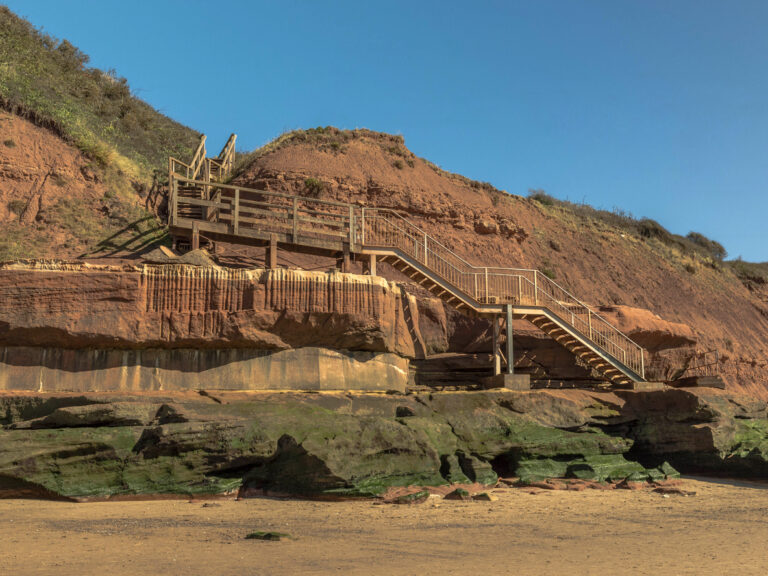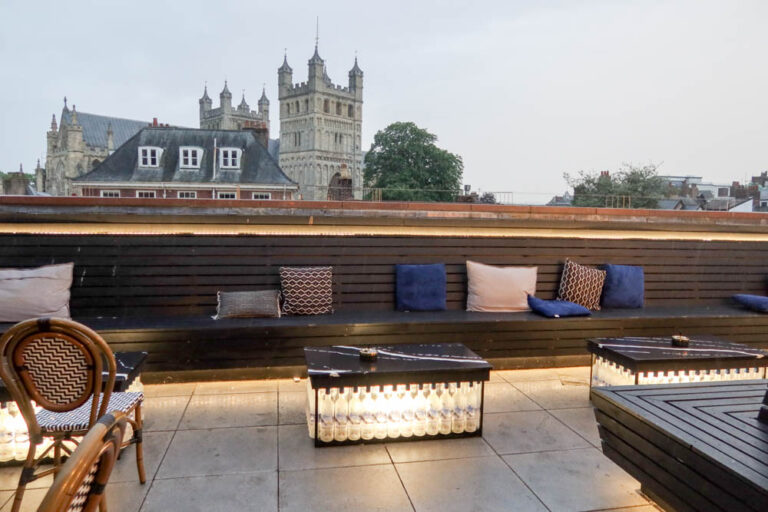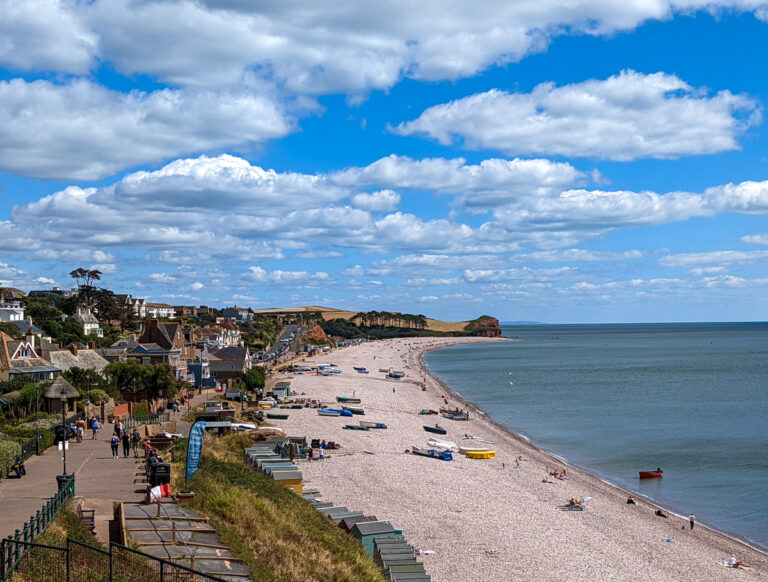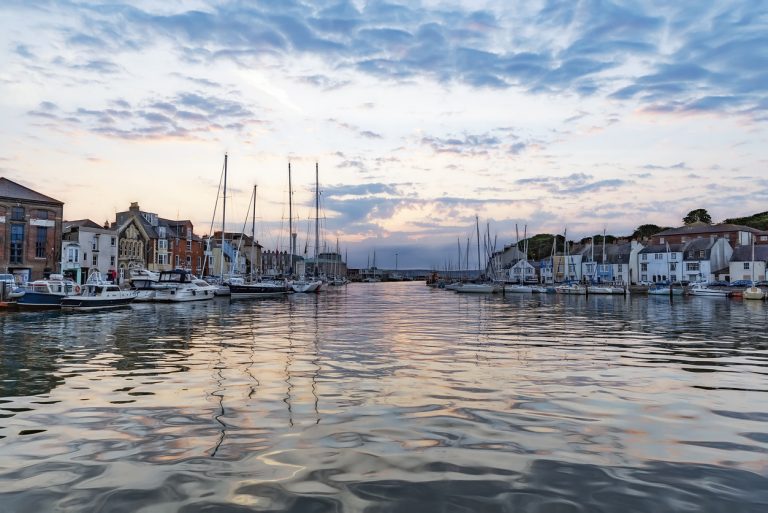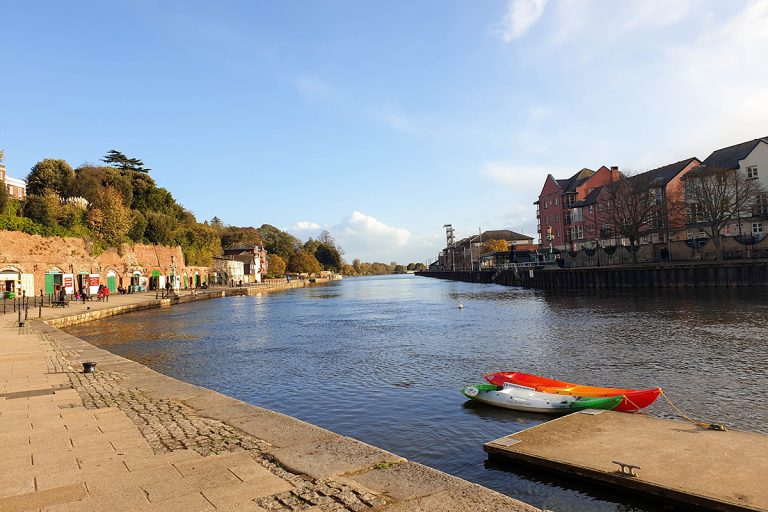Visiting the Jurassic Coast: full guide for 2024
Stretching 95 miles along the South coast of England, the Jurassic Coast winds through fossils and relics as it traverses 185 million years of history, from the 250 million-year-old Triassic rocks at Orcombe Point to the cliffs at Studland Bay (which are basically babies at only 65 million years old!).
Charismatic seaside towns, some of the UK’s best beaches and plenty of points of interest dot the route, meaning that while the Jurassic Coast is a fantastic spot for geological history, it’s also a must-visit for hikers, beachgoers, watersports fans or cultural enthusiasts.
It’s the only natural UNESCO World Heritage Site in the UK, a title awarded because of how it explores three distinctive Mezoic era records (Cretaceous, Jurassic and Triassic).
So, if you’re here, I’m guessing you’re keen to learn a little more about this encapsulating coastline?
You’re in luck – I live about a 20 minute walk from Orcombe Point, and I’ve spent many glorious days travelling all over the coast, in both Devon and Dorset.
In fact, while about 2/3s of the coastline is in Dorset, many tourists forget that the oldest part actually lies in Devon!
So this Jurassic Coast travel guide has all of my best tips for the coast along both counties, including where to visit, what to do, where to stay, and a comprehensive itinerary!
What is the Jurassic Coast?
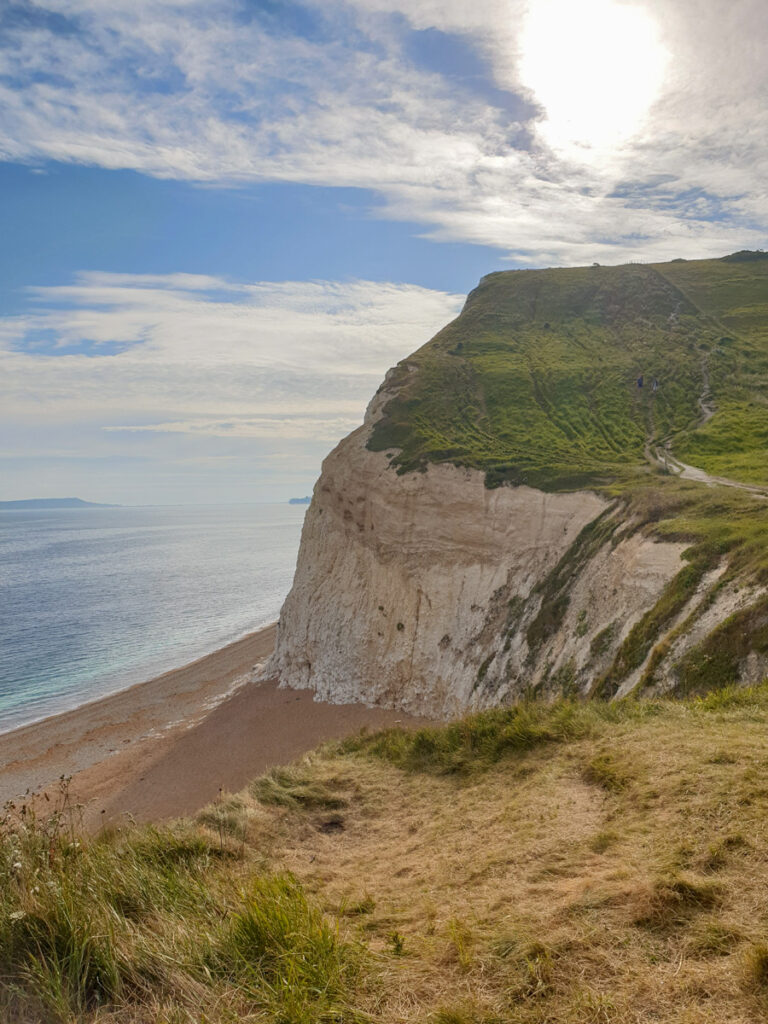
The Jurassic Coast unfolds over 95 miles on the south coast of England, its majestic sweep ranging from the rugged beauty of East Devon to the golden clifftops of East Dorset.
But the Jurassic Coast isn’t just a jaw-dropping fusion of scenic landscapes and coastal curiosities – it’s a walk through time itself!
As a natural UNESCO World Heritage site (the only of its kind in England!), it preserves 185 million years of Earth’s history in its rock formations – a powerful testament to aeons gone by.
Each cliff, pebble, and layer of sediment underfoot narrates an ancient tale, allowing us to glimpse epochs of the geological past, from the Triassic to the Jurassic and into the Cretaceous period.
Renowned as a fossil hunter’s paradise, the Jurassic Coast unlocks mysteries of a world long vanished, when dinosaurs roamed!
It’s been used by geologists and ancient historians to gain a full picture of what the ancient world looked like. In fact, it’s one of the most geologically important places in the world.
But the Jurassic Coast isn’t just a relic of the past, and there’s plenty for every day tourists to enjoy.
The coast’s been moulded continuously by the hands of nature, as you can see in its pristine beaches and spectacular hiking trails.
Over time, small seaside towns and villages have been established along the Jurassic Coast.
Some retain their historic buildings and boast tales of smugglers and pirates once you scratch the surface.
Others have modern attractions that are suitable for all the family, including petting zoos and theme parks.
The Jurassic Coast is where history meets beauty, where every rock holds a story, and where the sands of time are quite literally beneath your feet.
But its natural evolution has continued to create a prime UK holiday destination that any keen traveller should visit – it’s one of the best places to visit in Dorset and Devon!
History of the Jurassic Coast
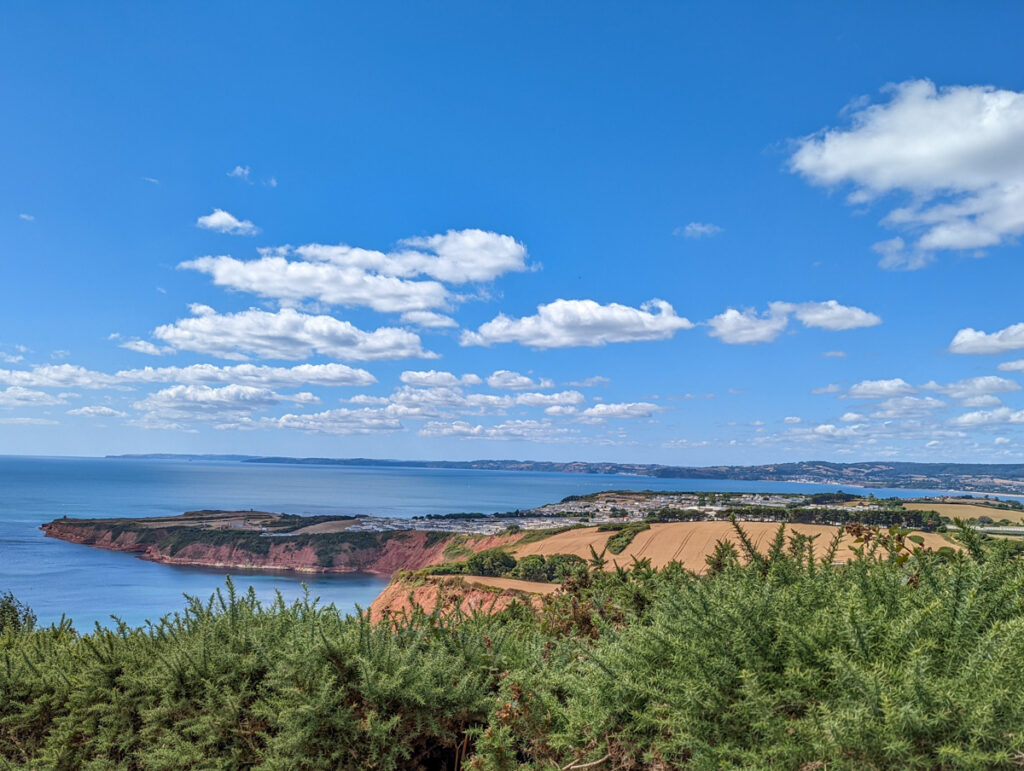
So, as I mentioned, the Jurassic Coast is up to 250 million years old, and it offers a walk-through time.
But what is the actual history of the Jurassic Coast?
Let me explain!
Triassic period
The story of the Jurassic Coast begins in the Triassic period, approximately 250 to 200 million years ago.
At this time, the region that is now Devon and Dorset was a vast desert environment, located near the equator.
This was because the continents all used to be one supercontinent called Pangea.
Pangaea existed during the late Paleozoic and early Mesozoic eras and encompassed all of Earth’s continental landmasses in a singular entity (this was approximately 335 to 175 million years ago).
Plate tectonics meant that the supercontinent eventually fragmented, and this resulted in the separate continents we recognize today, greatly influencing the climate, ocean circulation, and biodiversity of the planet.
As Pangaea was so large (it contained all of the earth’s landmass, after all!) its interior was very far from the moderating influence of the oceans.
In this desert landscape, streams formed temporary lakes and left behind sediment, including reddish sandstone and breccias, which is now visible in the red cliffs of East Devon.
Jurassic period
Moving into the Jurassic period, about 200 to 145 million years ago, plate tectonics caused significant changes.
Pangaea began to break apart, leading to the formation of shallow tropical seas over what is now Southern England.
These warm seas were rich in life, from tiny planktons to massive marine reptiles.
The prolific marine life and sediment from the sea floor led to the formation of limestone and mudstone, fossilizing many species within the layers.
The Jurassic Coast is particularly renowned for these well-preserved fossils, providing a significant record of marine life from this period; but this is why you’re most likely to find fossils in the Jurassic section (in the western and central part of Dorset).
Cretaceous period
The final geological period represented along the Jurassic Coast is the Cretaceous, from 145 to 66 million years ago.
The continuing separation of continents and consequent rising sea levels resulted in chalk deposition, especially during the Late Cretaceous.
This was the same geological process that Kent’s White Cliffs of Dover were born from.
Chalk is composed mainly of the microscopic shells of marine plankton that fell to the sea floor.
These organisms thrived in warm, nutrient-rich waters.
Over millions of years, the buildup of these tiny shells, combined with the weight of the water and additional sediment, compressed the remains into chalk.
Today, these deposits form the iconic white cliffs seen at locales such as Beer Head and Ballard Down, marking the most modern chapter in the Jurassic Coast’s ancient story.
Where is the Jurassic Coast?
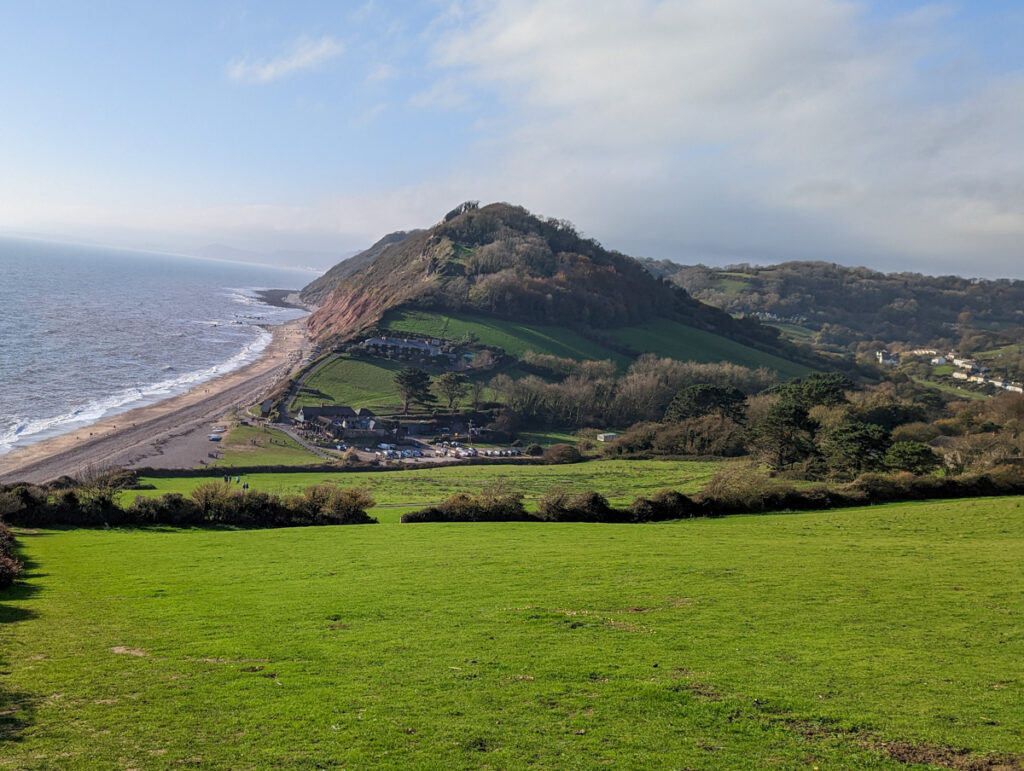
The Jurassic Coast encompasses most of Dorset’s coastline, and some of South Devon’s.
Commonly, media outlets focus only on the Dorset Jurassic Coast, leading many to believe that the coast is only in this county.
This isn’t true – there’s around a 30 mile section in Devon as well (and it’s just as beautiful, and even more ancient!).
Dorset and Devon are both counties in South West England, with Devon occupying the South West Peninsula that ultimately leads to Cornwall, and Dorset sitting to Devon’s east.
How to visit the Jurassic Coast
There are a few ways to visit and explore the Jurassic Coast, and the most suitable for you will depend on your group’s interests and abilities.
Here are a few options:
- Jurassic Coast road trip: Ideal if you want to see it all, are happy with long, busy days and are keen to stay somewhere different every night.
- Base in a main Jurassic Coast town: Perfect if you want to be in close proximity to a range of attractions and see a lot (but don’t mind not seeing it all) of the coast, and want to go back to the same place every night. The Jurassic Coast is even one of the best day trips from Bournemouth if you’d like to stay there.
- Base in a remote village: Ideal if you want a relaxing break to enjoy scenery and don’t mind driving a little to see any other areas of the coast.
- Jurassic Coast day trip: This is possible from areas around London, Bristol, Plymouth or Birmingham, but will be a long day with lots of travel and you will only see a section of the coast.
Things to do on the Jurassic Coast
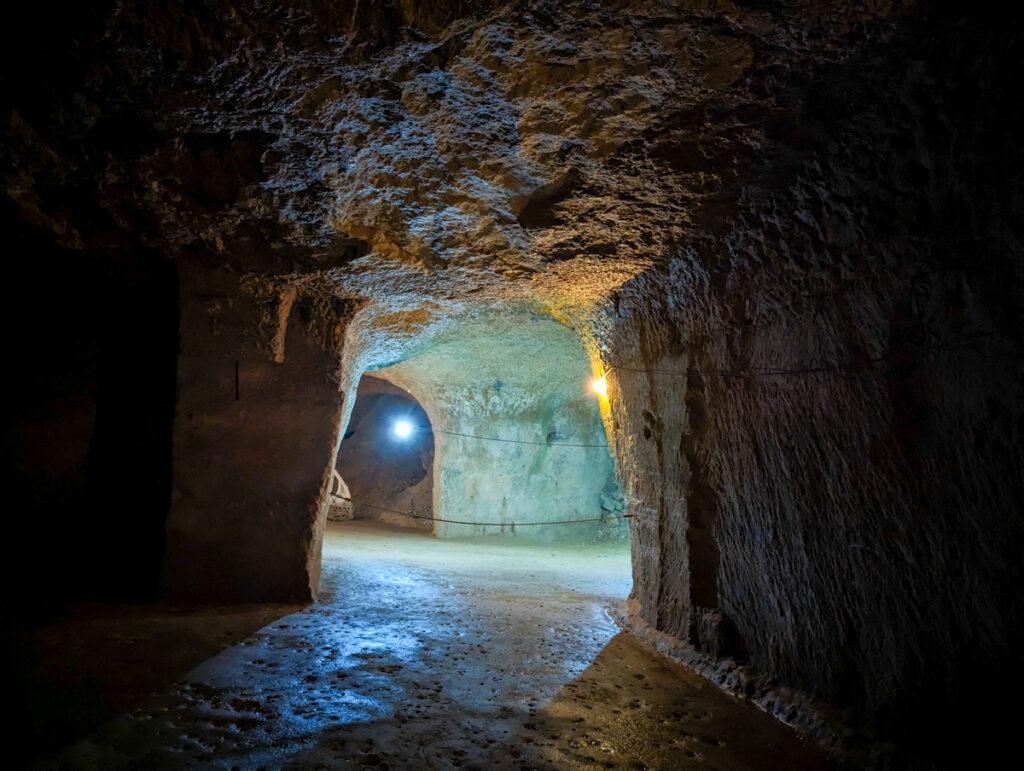
Tales of the natural history of the Jurassic Coast are certainly fascinating, but if you’re not a budding geologist – what is there to do on the coast?
Turns out, a lot!
Not only is it a geologically fascinating place to spend a few days, but it’s a stunning part of the world, with a lot of fantastic tourism infrastructure.
Whether you’re a hiker, beachgoer or historian, there’s something for you on the Jurassic Coast.
Here are a few ideas for things that you can do here.
Hiking
The Jurassic Coast Path is a section of the longer South West Coast Path which spans 630 miles from Minehead in Somerset to Start Haven Point in Studland (close to Old Harry Rocks at the end of the coastline).
This coastal trail offers a range of paths with varying difficulties.
I’ve completed most of the South West Coast Path in North Devon and Cornwall, and have done many short hikes in the Jurassic Coast section.
I love the Exmouth to Budleigh Salterton walk (which is my local), or you could also take an easy stroll around Durdle Door or walk from Beer to Seaton in East Devon.
Alternatively, take the fairly challenging route from Swanage to Old Harry Rocks or hike to Golden Cap, the highest point on the South England coastline.
Watersports
Lapped by gentle waves (they’re usually not too big on this part of the coastline), Jurassic Coast beaches are a hot spot for watersports.
Devon’s prime surfing beaches are all in the north (head to Woolacombe or Westward Ho!) – but Exmouth in particular is a top spot for watersports like stand-up paddleboarding, kayaking and windsurfing.
I’ve always seen stand up paddleboarders in Seaton and Beer too, which looks incredibly scenic.
And into Dorset, there are plenty of watersports opportunities in the busier towns of Lyme Regis and Weymouth; or, if you journey as far as Swanage, the clear water makes it a popular spot for scuba diving!
Exmouth boat trips
The best vantage point of the Jurassic Coast? The water, of course!
Sailing along the Jurassic Coast is a remarkable way to explore 185 million years of Earth’s history.
There are several boat trips that you can take from many of the main towns along the coast.
Stuart Line Cruises are popular in Exmouth; they offer Jurassic Coast tours that lead along to Ladram Bay, focusing on the oldest part of the coastline.
Poole boat trips
If you’re staying at the other end of the coast, check out this boat tour from Poole to Swanage, which sails past Old Harry Rocks.
Starting from the bustling Poole Harbour, embark on an open-deck boat, gliding past striking chalk formations and the golden beaches of Sandbanks, while immersing yourself in the fascinating commentary.
Witness the picturesque view of Round Island and the notorious Old Harry Rocks before heading to Swanage.
You can book this boat trip by clicking here!
Fossil hunting
Potentially the best thing to do on the Jurassic Coast, if you’re at all interested in the ancient history and rocks surrounding the coast, is fossil hunting.
Certain areas of the coastline are prime for looking for Jurassic Coast fossils; my local East Devon part isn’t amazing, but Charmouth (near Lyme Regis) and Chesil Beach are especially well-known for their abundance of fossils.
Take a look at fossil hunting walks in Charmouth by clicking here.
Specific attractions
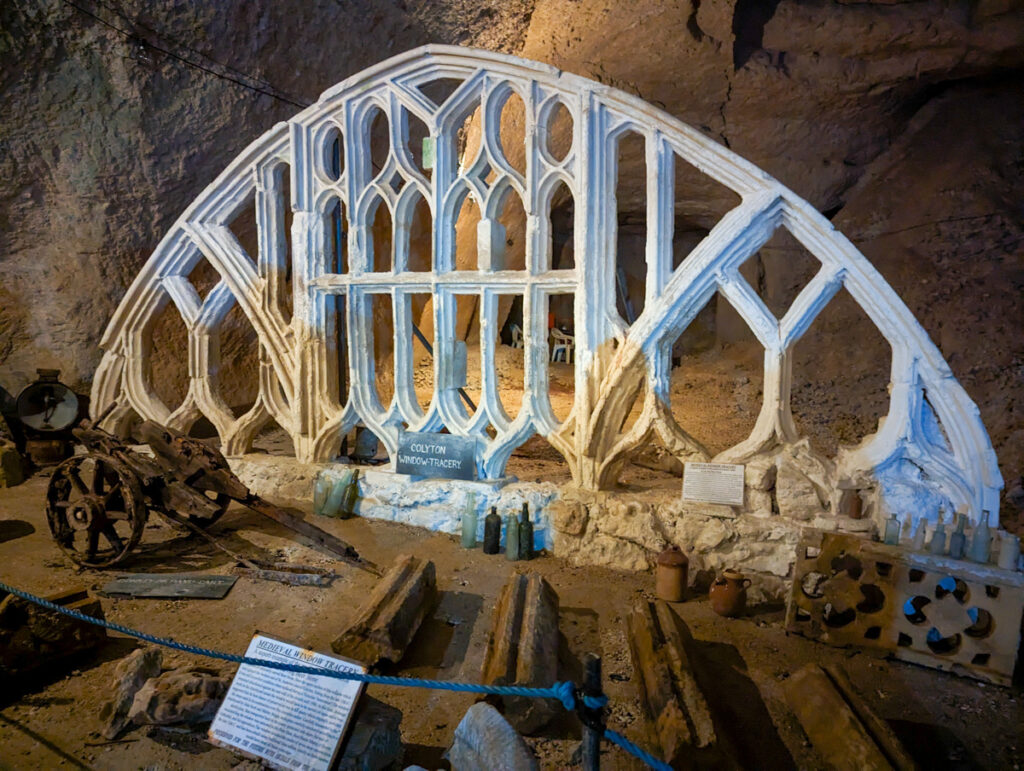
Coastal and non-coastal, there’s a plethora of incredible attractions along the Jurassic Coast.
Most of these are family-friendly, so you can intersperse your day at the beach with unique, interesting and fun things to do!
They include:
- World of Country Life, Exmouth: A family-friendly venue with interactive farm experiences, vintage exhibits, and indoor/outdoor play areas for a wholesome country experience.
- Sidmouth Donkey Sanctuary: This sanctuary provides a haven for rescued donkeys, offering visitors the chance to learn about and interact with these endearing animals in a peaceful rural setting.
- Beer Quarry Caves: A large man-made complex of underground caves in Beer, renowned for its historic role as a source of high-quality limestone since Roman times.
- Seaton Tramway: Enjoy picturesque journeys through the Axe Valley aboard heritage trams, offering unique views of the local countryside and the River Axe estuary.
- Abbotsbury Swannery: The only place globally where you can walk amidst a colony of nesting Mute Swans, delivering a unique wildlife experience.
- Lulworth Castle: A 17th-century castle originally built as a hunting lodge, featuring attractive grounds, fascinating historical exhibits, and stunning tower views.
- Corfe Castle: Standing as an emblem of a thousand years of history, the dramatic ruins of Corfe Castle offer breathtaking views over the Purbeck countryside.
Learning about culture and history

The Jurassic Coast isn’t an urban place, but small towns and villages have grown along the coastline throughout the centuries, and there are plenty of fascinating stories from smugglers, pirates and tourists throughout!
I’ve recently started walking tours in Exmouth to showcase the history of my hometown, where I delve into the fascinating history of this coastal town – I tell tourists about its links to Lady Byron and Nelson, why George III’s personal physician recommended a visit and show the exact smuggling route that was taken in the 18th centuries!
There are also walking tours in Sidmouth which focus on its status as a regency town and a range of fascinating museums along the coastline, including Exmouth Museum, Sidmouth Museum and Lyme Regis Museum.
Top places to visit on a Jurassic Coast road trip itinerary
The best places to visit on your Jurassic Coast road trip itinerary include clifftops like Old Harry Rocks and Durdle Door (the official end of the coast), historic sites like Corfe Castle and Lulworth Castle, villages like Charmouth and Abbotsbury, epic beaches and bustling towns such as Exmouth, Sidmouth and Lyme Regis.
1. Old Harry Rocks
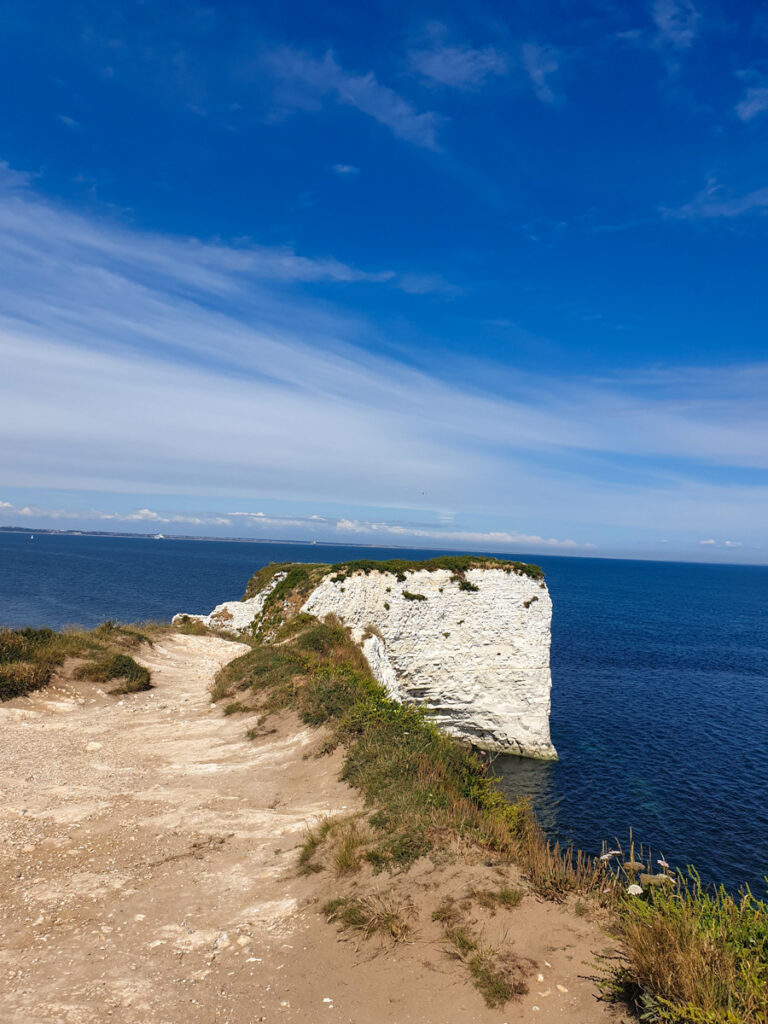
Often the first stop on a Jurassic Coast road trip itinerary, the chalk stacks of Old Harry Rocks date back to the Late Cretaceous period.
The brilliant ghost white of the stacks contrasts with the waters of Studland Bay to the north and Swanage Bay to the south.
Owned by the National Trust, this stop on a Jurassic Coast drive may be the youngest (at 65 million years, it’s an infant compared to East Devon’s 250 million-year-old Triassic Cliffs!), but it’s a fascinating way to see this part of geological history right before you.
Stop for photos, admire the view, or take a walk around the area.
It’s around an hour’s walk to Swanage, the next stop on your Jurassic Coast trip – or you could drive (10 minutes) or take the Breezer 50 open-topped bus from nearby Studland.
2. Swanage

Swanage is a chilled-out beach town with eateries lining the sands and a historic pier.
It’s famous for its heritage steam railway and proximity to other attractions on the Isle of Purbeck.
But it’s just as popular for lazing on the beach, snorkelling in the waters or even going scuba diving – it’s one of the most popular places for diving in the UK.
3. Corfe Castle
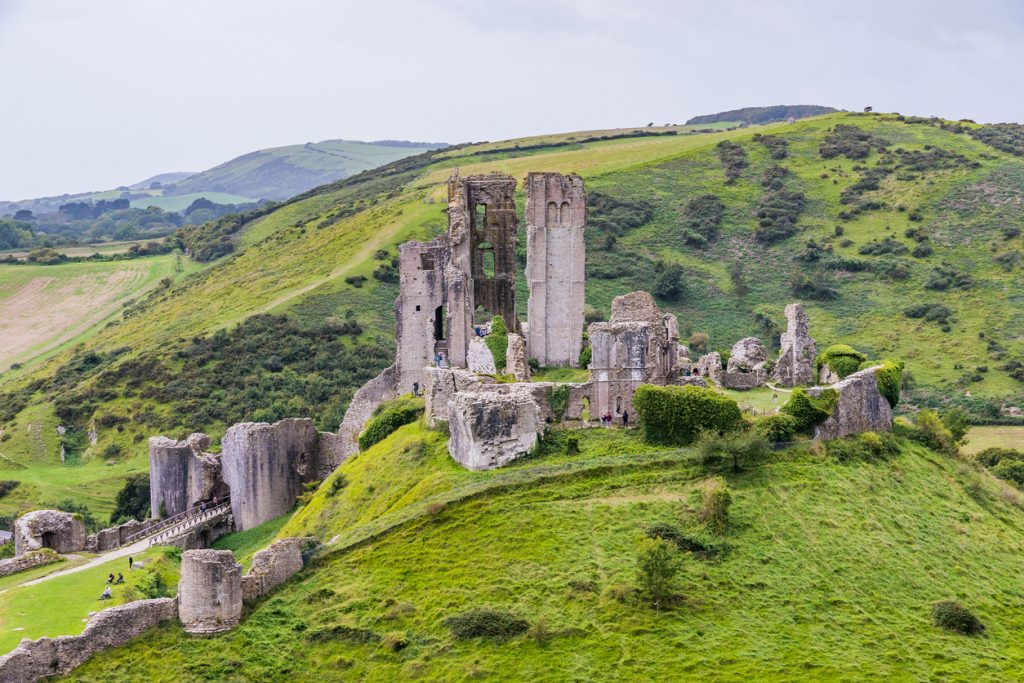
Inland slightly from the coastline – but well worth a stop on any Jurassic Coast itinerary – the imposing Corfe Castle dates back to just after the Norman Conquest in 1066 – it was founded by William the Conqueror who saw it as a military significant location.
Over the years, it’s been the setting for Medieval royal murders, as a political prison and sieges during the English Civil War.
Nowadays, it stands in a semi-ruinous state, but remains an arresting site at the top of a hill in the village of Corfe Castle.
It’s owned and managed by the National Trust.
National Trust members can access it for free (read my full National Trust membership review to decide if it’s right for you!) or non-members can pay for entry.
4. West Lulworth and Lulworth Cove
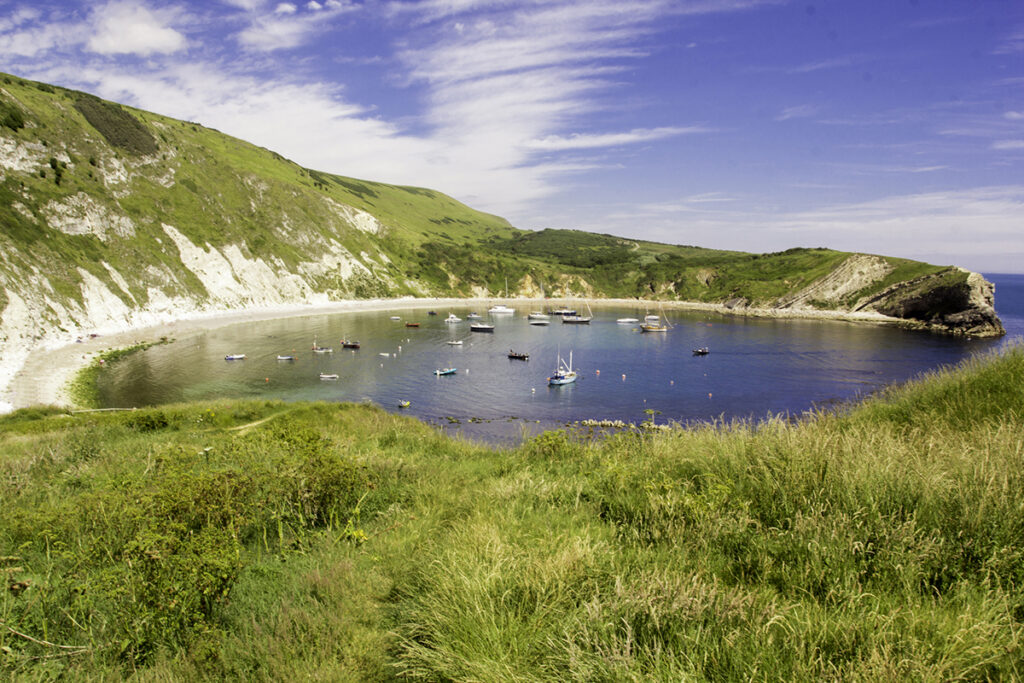
Tourists often head straight to Lulworth Cove, a near-circular beach that, along with nearby Durdle Door, often makes its way onto Jurassic Coast marketing material.
The cove is often photographed from above, the almost geometric shape, carved over millions of years by the sea, making it into countless holidaymakers’ photo albums!
Due to its circular nature, it’s possible to walk around the circumference, enjoying the view from multiple angles.
Ultimately, you can descend onto the sand, where the sea makes a calm swimming spot – although do be careful if you swim here, as there’s no lifeguard coverage.
The village of West Lulworth, a 15-minute walk inland, is worth a stop off too.
Small and quiet it may be, but it’s lined with charming thatched-roof houses (quintessential of the English countryside!), one of which is the Castle Inn Pub, a country inn that dates back to 1660.
5. Durdle Door
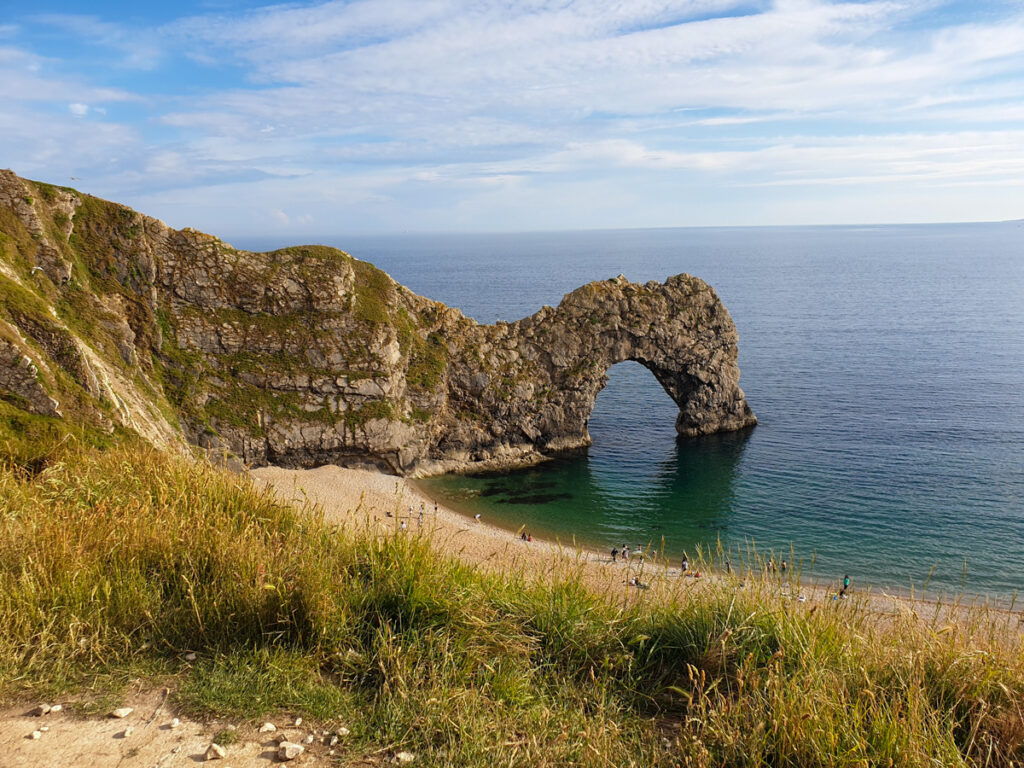
A quick drive or 30-minute walk along the coastline takes you to Durdle Door, possibly the most famous part of the Jurassic Coast!
Durdle Door is a rocky archway stretching out from the cliffs into the sea.
The arch itself dates back around 10,000 years – when the sea eroded the centre to create the structure that stands today.
Nowadays, it frames one end of the beach and tends to be the iconic image that most associate with the coastline!
There’s a caravan park right above Durdle Door – staying here means you can be the first person at the arch in the morning – or you can enjoy coast path walks and head down to either Durdle Door or neighbouring Man O’ War Beach.
Swimming at Durdle Door isn’t recommended due to currents and lack of lifeguard coverage.
6. Weymouth
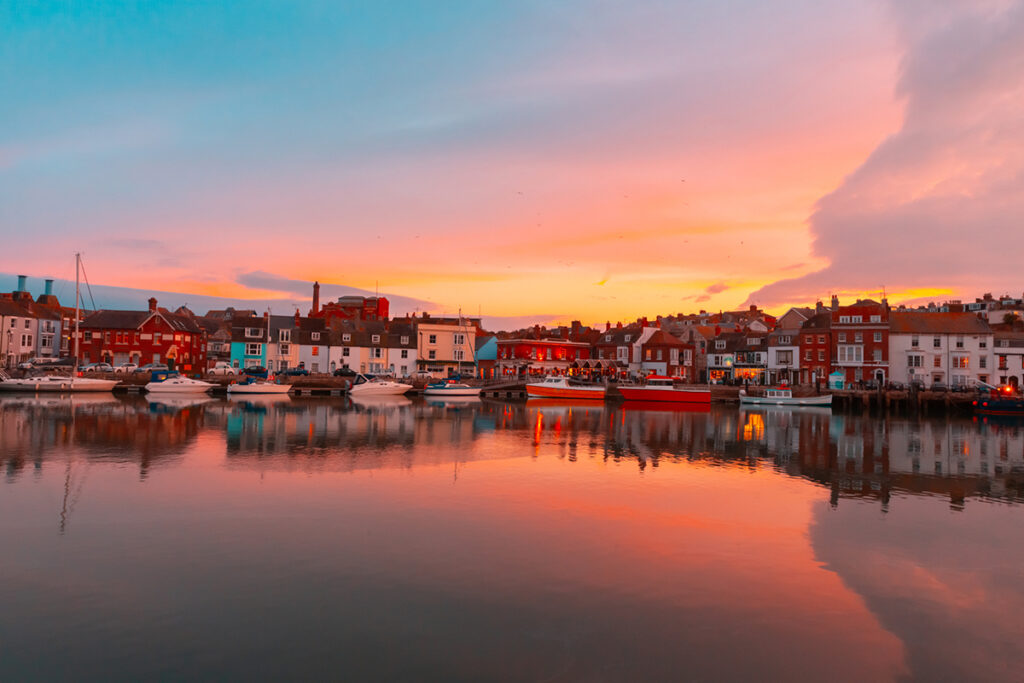
Pastel-coloured terraced houses lining a historic harbour, with beaches a stone’s throw away, Weymouth is the embodiment of a quintessential British seaside town.
Being one of the larger towns on the Jurassic Coast, Weymouth’s a fantastic hub – you could stay here and go on day trips around the area and spend a few days soaking in the vibe of Weymouth itself.
The best attractions in town include the historic Nothe Fort which dates back to the end of the 19th century and SandWorld which exhibits a range of atwork, with a difference – they’re all made out of sand!
Of course, Weymouth Beach can’t be missed, and neither can traditional fish and chips sitting by the harbour – this is what the British coastline is all about!
7. Isle of Portland
The Isle of Portland is what is known as a “tied island”; an island connected to the mainland only by a bar of sand, otherwise known as a “tombolo”.
In this case, it is the 18-mile-long Chesil Beach, which we’ll cover in a moment!
The Isle of Portland is possibly mostly renowned for Portland Stone, which is sturdy yet carvable and has been used in many British landmark buildings (including St Paul’s Cathedral and Westminster Abbey) and has even been transported overseas to be used in places like the United Nations Headquarters in New York City!
The South West Coast Path loops around the entire island (it’s generally completed by hikers in a day) and here, you can go rock climbing or try out numerous watersports.
In fact, the National Sailing Academy is right on Portland – which was used in the 2012 Olympics and Paralympics!
Most tourists to the island visit the Portland Bill Lighthouse and visitor centre, where you can ascend 153 steps to catch an extraordinary view from the top and learn about the significance of the lighthouse on Dorset’s southernmost point.
8. Abbotsbury
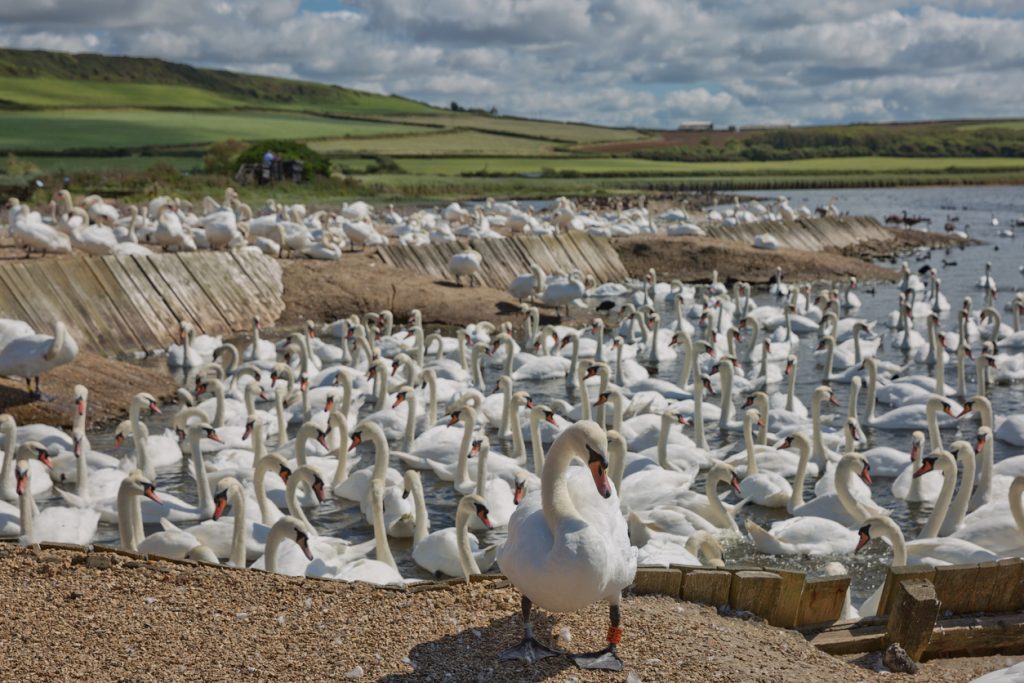
With an extraordinary history dating back a whopping six millenia, Abbotsbury has Neolithic, stone age, bronze age and Roman history; and was officially settled when it became residence for Saxon pirates!
The Abbey was founded in the 11th century during the reign of King Cnut, and the ruins are still visitable today.
Nowadays, the town’s most famous for its Abbotsbury Swannery; the only managed colony of nesting mute swans in the world.
The Abbotsbury Subtropical Gardens are also worth a visit; the village sits within its own microclimate thanks to its sheltered surroundings.
Plus, it’s a stone’s throw from the almighty Chesil Beach, a must stop on any Jurassic Coast itinerary!
9. Chesil Beach
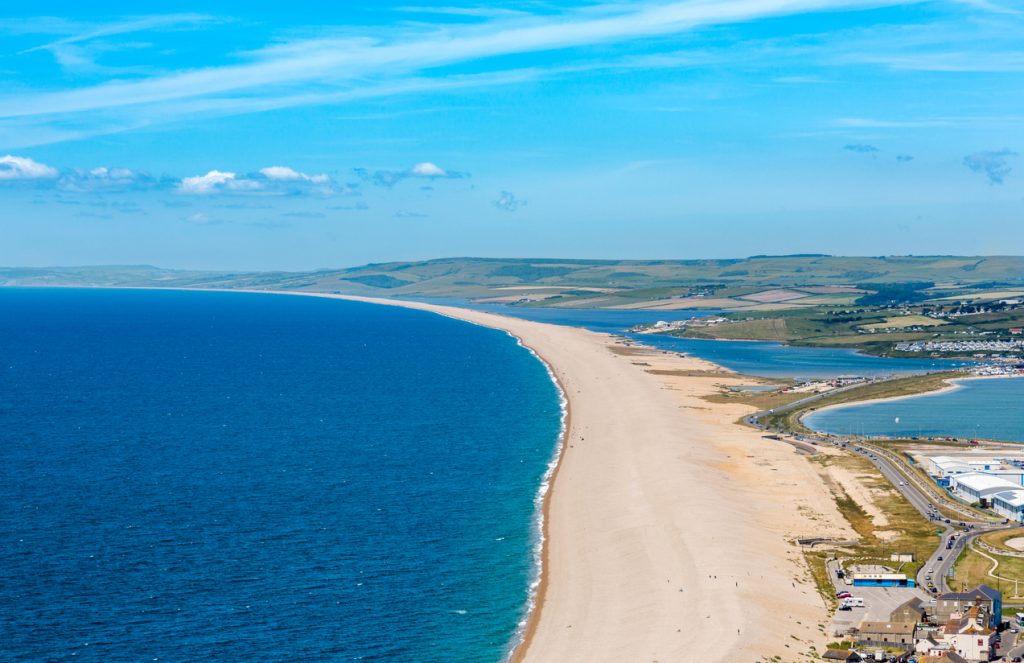
Undoubtedly one of the best beaches in Dorset, Chesil Beach is a vast 18 mile stretch that’s been moulded by the elements over the years.
It’s a barrier beach that stands between the sea and Fleet Lagoon, England’s largest lagoon and an SSSI (Site of Specific Scientific Interest).
Along with the Abbotsbury Swannery, here you can expect to see birds like little egrets, dark bellier brent geese and common greenshanks. If you want to get up really close and personal with the Fleet Lagoon’s wildlife, boat trips operate on the Fleet Explorer.
The lagoon was also one of the locations where the Bouncing Bomb (immortalised in the film The Dam Busters) was tested during World War II.
You can still see evidence of Chesil’s defending role in the war in the shape of old anti-tank blocks and concrete pillbox remains.
Chesil Beach Visitor Centre explains the geology of this unique stretch of sand.
But of course, the best way to soak it all in is to head to the beach itself.
Go fishing, walk along the sand or simply relax and do nothing – that’s what Great British holidays are all about, right?
10. Bridport and West Bay
Situated slightly inland, Bridport’s a bustling market town that was once the regional centre of ropemaking (to this day, it’s still known as “Rope Town”!).
A lovely town to potter around in, perhaps on a day when the weather’s a little gloomy, Bridport’s home to 13th-century buildings The Chantry and St Mary’s Church and an imposing Town Hall that dates back to the late 18th century.
The Bridport Museum showcases an array of local artwork and displays about its history, and the River Brit spans the town.
West Bay is a mere two miles away – in fact, the harbour at West Bay is called Bridport Harbour.
If you’re a fan of TV show Broadchurch, you’ll recognise West Bay – much of the show was shot in the area.
Tucked in between cliffs, it’s an unassuming yet spectacular village.
One of the most popular things to do here is to hike to Golden Cap, which is the highest point of the Jurassic Coast (although not the highest on the South West Coast Path – that’s Hangman Point in Exmoor!).
11. Charmouth
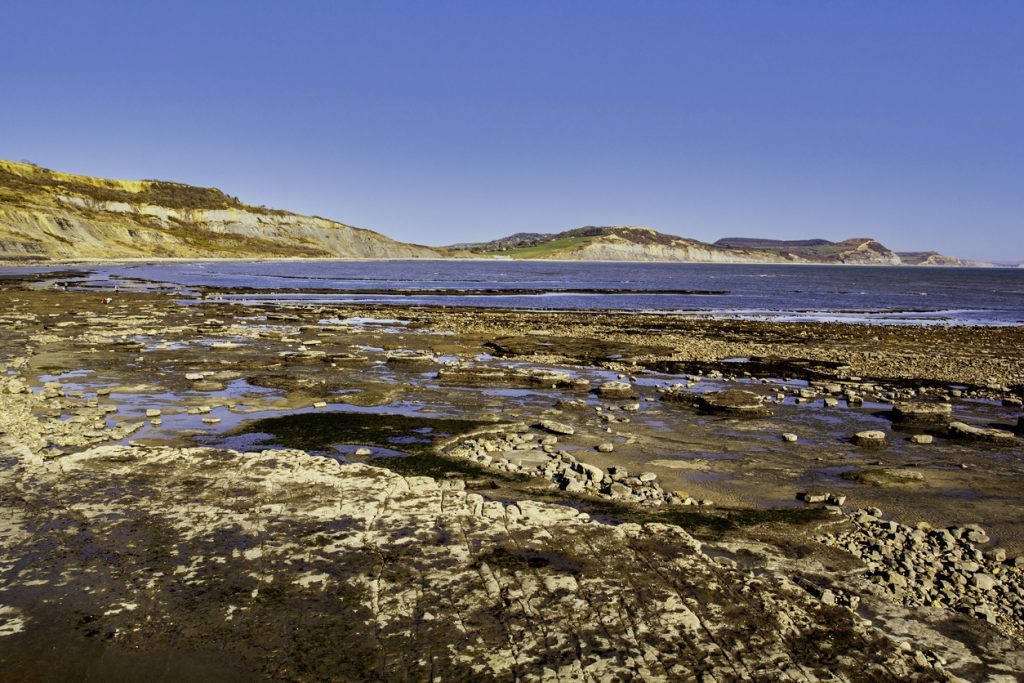
Charmouth – it’s charming!
A short distance from Lyme Regis, Charmouth is mostly renowned for its fossils, making exploring the beach like walking around a living museum.
The Charmouth Heritage Coast Centre explains why the village’s beach is so fossil-rich and organises regular expeditions to find fossils.
The village boasts St Andrew’s Church, which was rebuilt in the late 19th century and is made from stone and flint.
There are also some excellent pubs in town, including the Royal Oak Inn and The George.
12. Lyme Regis
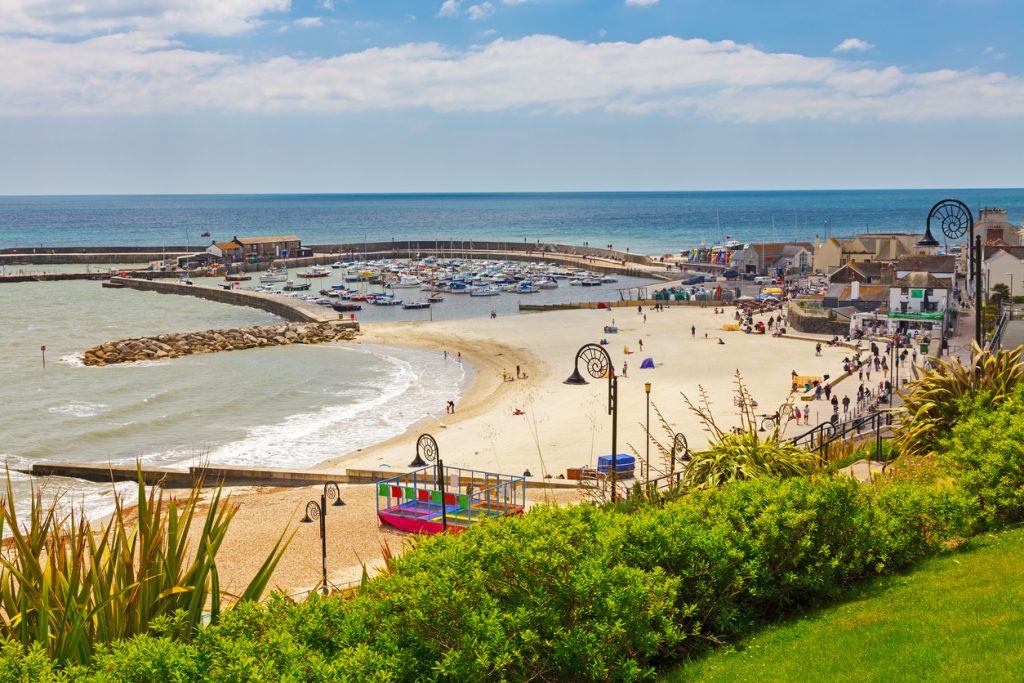
The last town in West Dorset, Lyme Regis is a genteel settlement in the heart of the dinosaur coast!
Often called the “Pearl of Dorset”, Lyme Regis was granted a royal charter in the 13th century (which is where the “Regis” part of its name comes from!).
The home of celebrated fossil collector Mary Anning – who found some extraordinary fossils in the 19th century, although sadly never got the recognition she deserved while she was still alive due to her lower class – Lyme Regis hosts an annual fossil festival each year.
There are four beaches in town – Front Beach is sand and shingle, whereas Monmouth Beach is pebbly – and it’s a popular spot for watersports or enjoying fish and chips or an ice cream while looking over the water!
13. Seaton
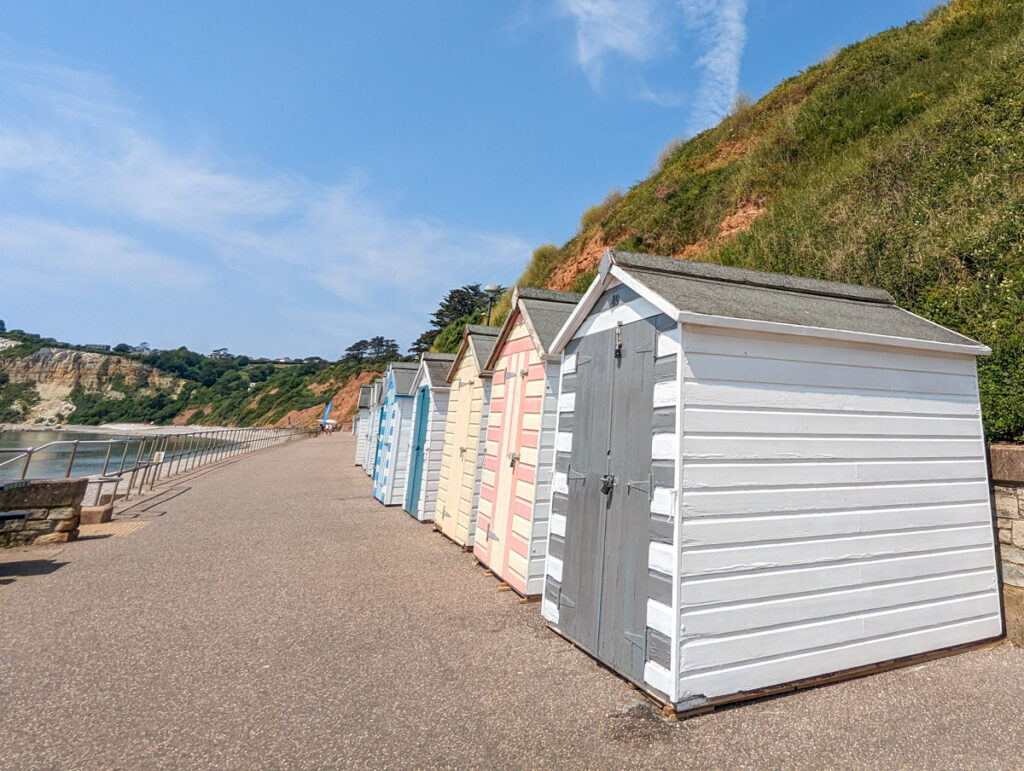
Seaton’s a small town in the Easternmost part of Devon, home to a pebbly beach, laid-back town centre, striking cliffs and the Seaton Tramway, a network of vintage double-decker trams.
The Seaton Tramway leads up through the Axe Estuary, terminating at the pretty market town of Colyton.
On the way, you’ll pass through the Seaton Wetlands where you can watch out for birdlife and the small village of Colyford.
I recently went on the Seaton Tramway for the first time in a few years, and it was even better than I remembered – it’s a completely unique way to see this part of East Devon!
14. Beer
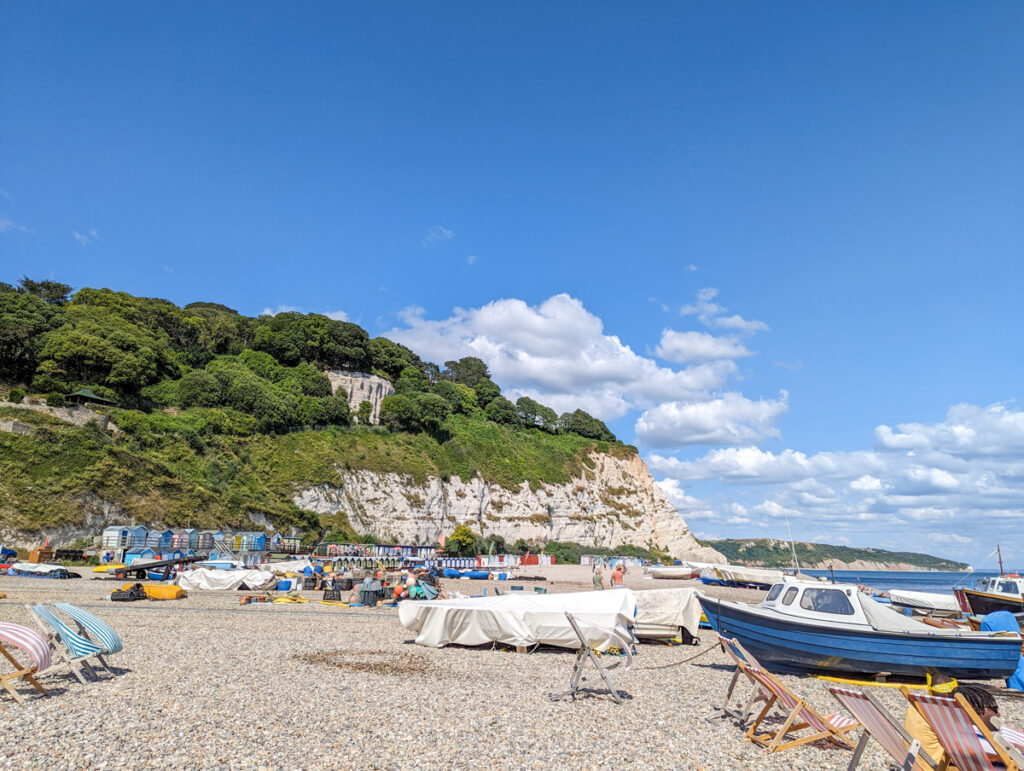
The quaint village of Beer has nothing to do with the alcoholic drink, but it’s renowned for its striking chalk cliffs and famous caves.
The shingle beach is tucked in between cliffs – the pebbles don’t entice sunbathing or picnicking, but you can rent out a deckchair for the day – or head to the viewpoint near the RNLI shop for one of the best views in town.
Have a beer in Beer at the Anchor Inn or aptly-named Barrel of Beer, or head on a longer walk to Seaton or Branscombe via Beer Head.
Don’t miss the Beer Quarry Caves – vast man-made limestone caverns that have been used as a source of high-quality stone since Roman times.
You can take a guided tour around the caves, where you’ll learn about their history and geological significance.
15. Branscombe
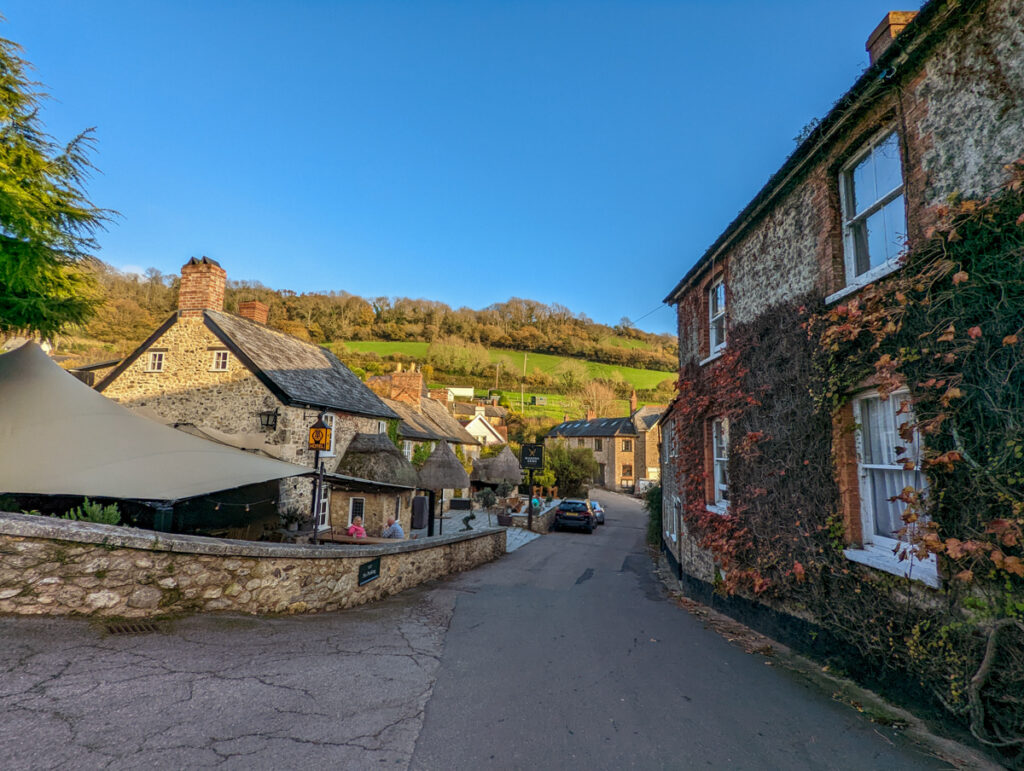
One of my favourite Jurassic Coast villages in Devon, Branscombe is tiny – although it does earn the reputation of being the longest village in the UK, due to the fact that pretty much the entire village is placed along one, very long, road!
The village itself is dotted with thatched-roof cottages and a friendly pub, The Masons Arms (which dates back to the 14th century) serves slap-up hearty meals.
The pebbled beach is usually peaceful, and there’s a short-but-sweet summit where you can take above-neighbouring cliffs to take in a view of the surroundings.
The only downside is that driving to Branscombe can be hair-raising to say the least – it’s a voyage off the main roads and down twisting country lanes!
Check out my full guide to Branscombe by clicking here.
16. Sidmouth
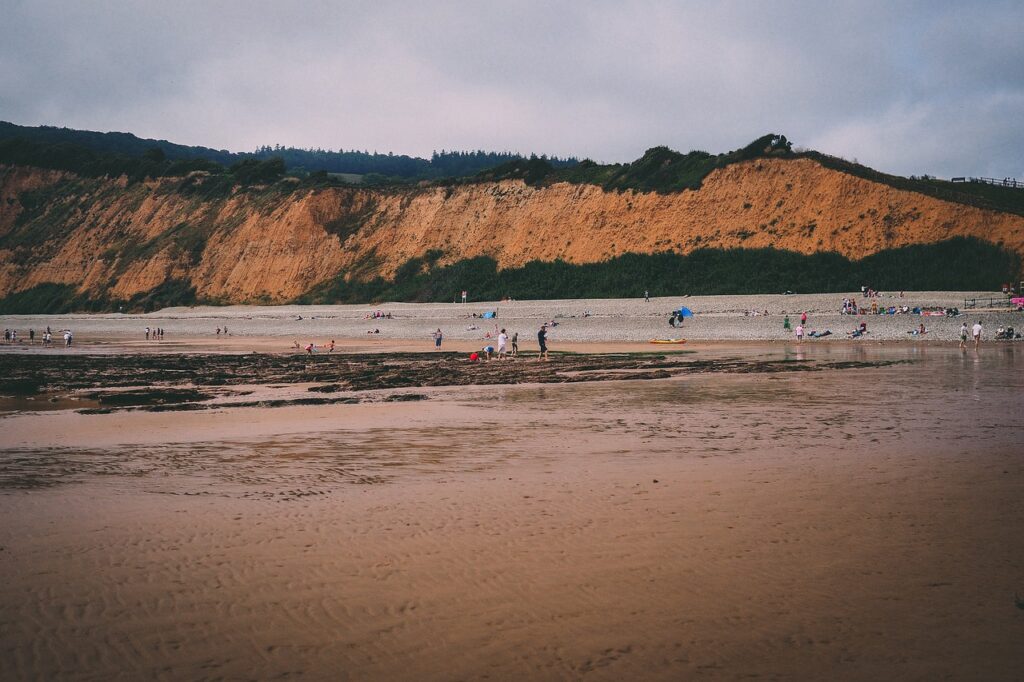
Historically one of the favourite tourist towns in Devon – Queen Victoria herself lived here – Sidmouth is tucked away between Jurassic Coast cliffs, and is renowned for its array of hotels, beautiful gardens and, of course, walks along the South West Coastal Path.
A relatively sizeable town (although not as big as nearby Exmouth), there’s a handful of pubs and restaurants here, along with a sand and shingle beach and the famous Jacob’s Ladder, a series of steps leading above the beach to Connaught Gardens.
Here’s my list of the best things to do in Sidmouth.
17. Ladram Bay
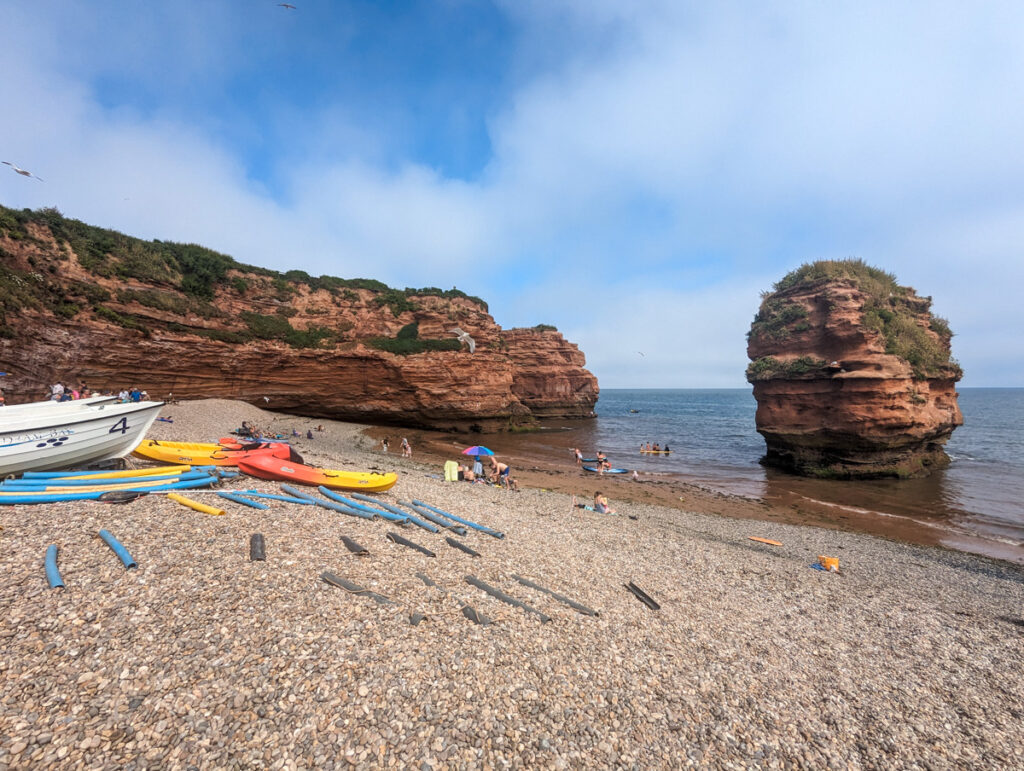
Ladram Bay’s one of my favourite beaches to really feel like you’re in the thick of the Jurassic Coast.
Red Triassic rocks loom on either side, and there’s a stump in the middle of the beach.
This beach is private and attached to Ladram Bay caravan park; driving here isn’t permitted in the summer season, although it’s open to all in the winter.
If you’re visiting in the summer, I recommend taking a Jurassic Coast Stuart Line Cruise in Exmouth.
I did this last summer, and it involved sailing towards Ladram Bay and moving close towards the rocky outcrops.
With a full commentary, you’ll learn plenty about the Jurassic Coast and see some mesmerising shots of the shoreline as you go.
I also love the village of Otterton, which is located just inalnd of Ladram Bay.
18. Budleigh Salterton
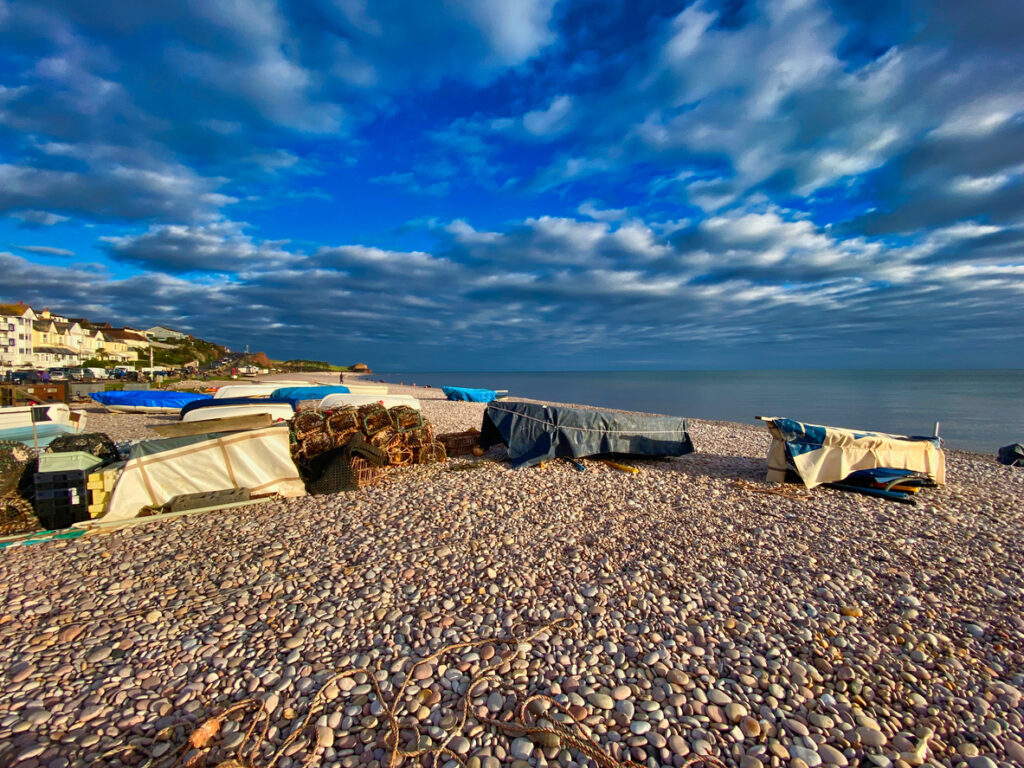
The last “official” town on the Jurassic Coast, Budleigh Salterton is a relaxed place, with an expansive pebbled beach (which means that it never gets quite as busy as neighbouring Exmouth) and a genteel high street.
Its eastern end sits at the mouth of the River Otter, somewhere that, despite the name, is actually the home of a group of beavers!
You can walk along the River Otter to Otterton (famous for its historic water mill), although the beavers are most active at dawn.
I love coming here on walks from Exmouth, but Exmouth Beach has much more on offer in terms of activities.
19. Orcombe Point

The official end of your Jurassic Coast trip (although I’d recommend extending to Exmouth – it’s the only logical place to go from Budleigh Salterton!), Orcombe Point is a rocky outcrop sitting at the furthest end of the coastline.
It’s home to the Geoneedle, a manmade obelisk that marks the official start of the coastal path.
It was unveiled in 2002 by the then Prince Charles and is made out of seven rocks that can all be found along the coastline.
There’s a hopscotch leading toward the stone, with each square defining a moment of Jurassic Coast history; so you can hop towards the Geoneedle and hop through time!
Orcombe Point is about 500 metres from the path that descends down to Exmouth Beach.
20. Exmouth
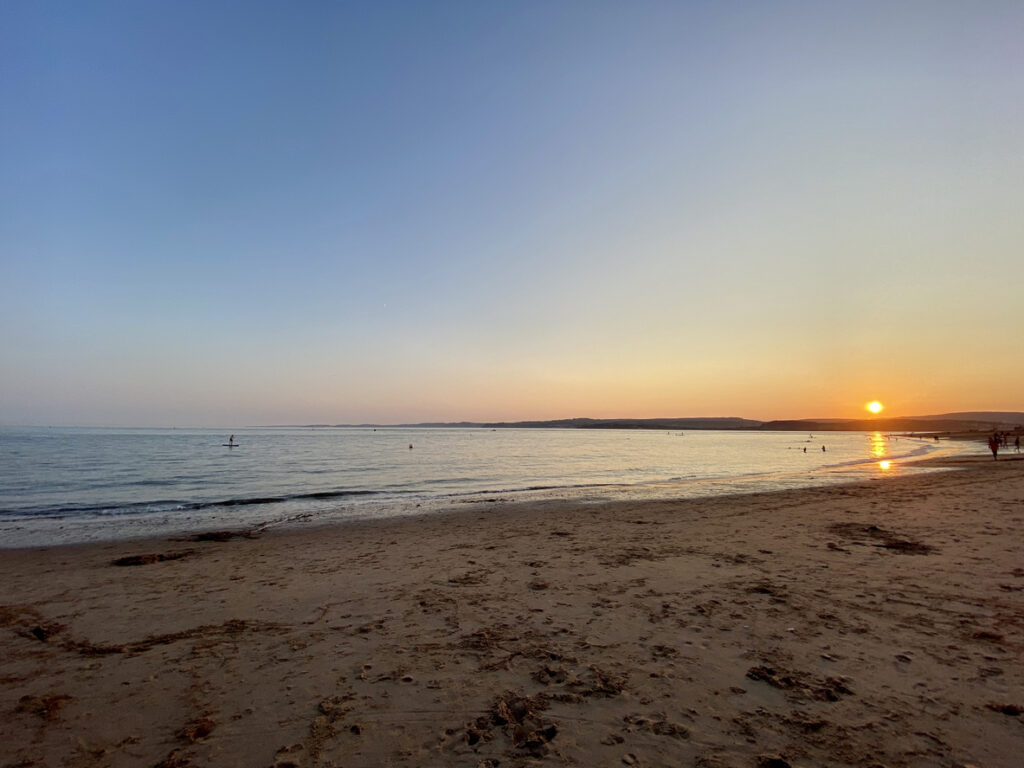
As your journey along the Jurassic Coast nears its end, Exmouth, in the southwest corner of East Devon, offers the perfect finale.
I live in the town, so I’m a little biased, but I believe that Exmouth is a fitting tribute to the stunning natural beauty and rich history encapsulated in this UNESCO World Heritage Site.
The town’s most arresting feature is its majestic red sandstone cliffs, which lead up to Orcombe Point – the official beginning of the Jurassic Coast.
On clear, sunny days, Exmouth Beach teems with activity, as locals and visitors alike take pleasure in the seaside’s gentle charm.
In contrast, the Exe Estuary, teeming with birdlife, provides a lively spectacle for nature enthusiasts. This isn’t technically a part of the Jurassic Coast, but it’s at the other end of the beach!
There’s plenty more to do in Exmouth, renowned as Devon’s oldest coastal resort and its fifth-largest town.
For starters, you could take a walking tour (with me!) to learn about the town’s heritage and culture.
Check out my walking tour website by clicking here.
Take a Stuart Line Cruise back along the coastline or embark on a trip along the estuary.
Alternatively, feel the adrenaline surge of watersports against the backdrop of the ancient coastline.
Above the town sits the peculiar 16-sided house, A La Ronde, which is a testament to architectural curiosity.
Significantly, Exmouth serves as the gateway to the Jurassic Coast, and as such, it carries an air of importance in the region’s geological narrative.
As I live in the town, I’ve wrote a few guides to Exmouth! Here’s my full list, all full of local tips:
- Best things to do in Exmouth
- Best restaurants in Exmouth
- Holidays in Exmouth travel guide
- Best places to stay in Exmouth
- Top beaches in Exmouth
- Incredible walks in Emxouth
Jurassic Coast itinerary
Your Jurassic Coast itinerary begins at Old Harry Rocks and terminates at the wonderful Exmouth Beach!
This itinerary takes five days, but you could extend it if you’d like to spend more time in any of the locations.
Day 1: Old Harry Rocks, Swanage, and Corfe Castle
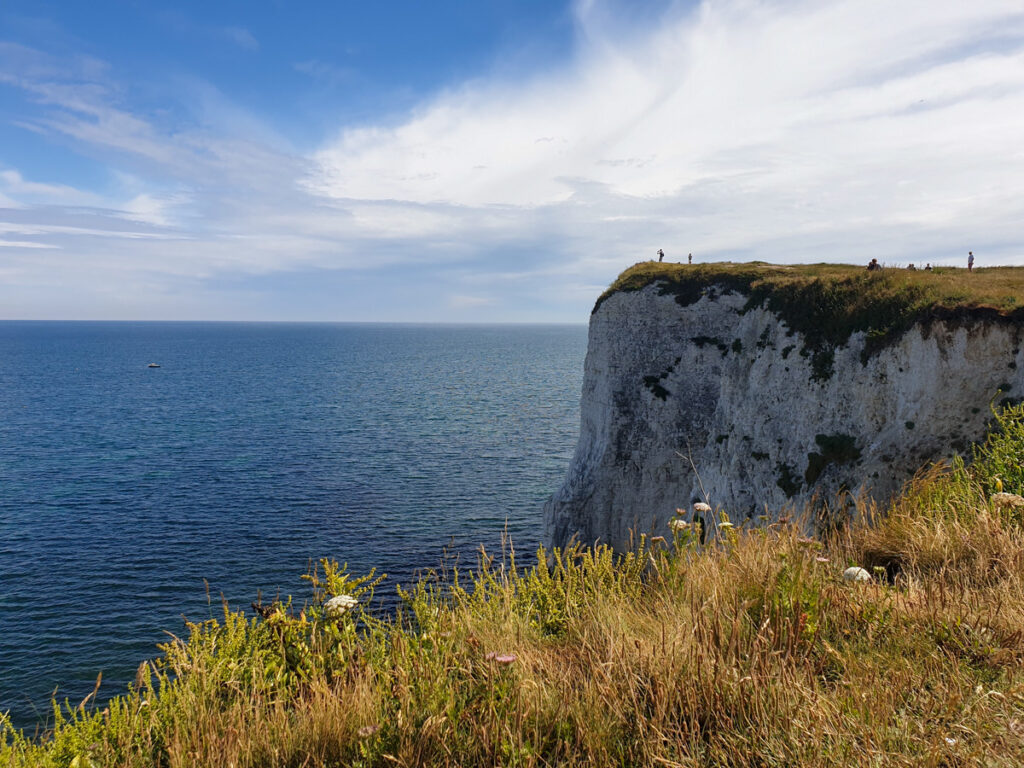
Start your Jurassic Coast road trip at Old Harry Rocks.
Take an invigorating morning walk to see these striking chalk formations.
Afterwards, head south (10-minute drive) to the coastal town of Swanage.
Here, you can explore the Victorian Pier, visit the Swanage Railway, or just bask on the beach – it’s a sheltered bay, making it a popular spot for swimming!
Wrap up your day with a short drive to the historic Corfe Castle (15-minute drive), enjoying its stunning ruins and charming village.
Stay overnight at the Morton’s House Hotel, a 16th-century manor house hotel in the village of Corfe Castle. Click here to read more about the hotel.
Day 2: West Lulworth, Durdle Door, and Weymouth
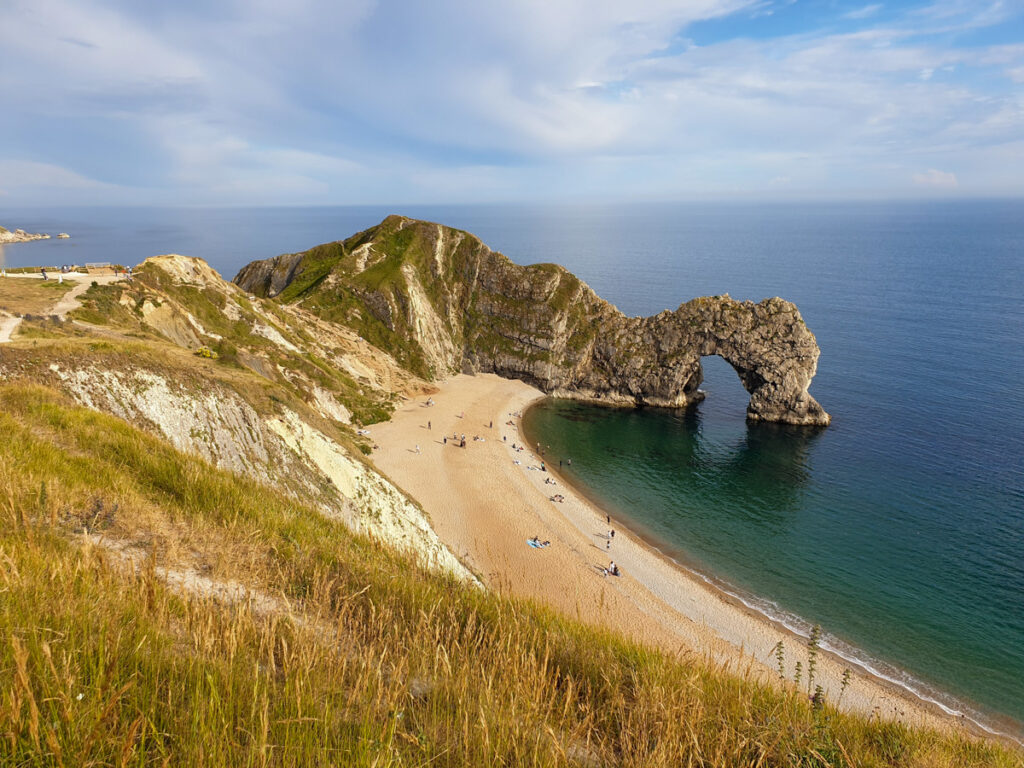
After breakfast, head to the picturesque village of West Lulworth (20-minute drive).
Hike out to Lulworth Cove, and then follow the coast path to Durdle Door (around one hour).
Take a dip in Lulworth Cove if you fancy – swimming at Durdle Door isn’t recommended.
You can either hike back or take the 30 or X50 bus back to West Lulworth.
After lunch, continue to Weymouth (30-minute drive).
Explore the historic harbourside, see sand sculptures at Sand Life, and visit the Sea Life Centre.
Stay overnight at the boutique Gloucester House, situated on the seafront in Weymouth. Click here to read more about this hotel.
Day 3: Isle of Portland and Abbotsbury
Start your day with a trip to the Isle of Portland (20-minute drive).
Explore the historic Portland Bill Lighthouse, and grab some lunch with a view at Heights Hotel. After a local seafood lunch, head to Abbotsbury (30-minute drive).
Here, spend your afternoon visiting the renowned Abbotsbury Swannery and exploring its subtropical gardens. Make your way to the historic market town of Bridport (15 minutes away) for the night.
Relax and refresh at The Bull Hotel, an elegantly refurbished 16th-century boutique inn in the heart of Bridport. Click here to read more about it.
Day 4: Bridport, Charmouth, and Lyme Regis
Start your day in Bridport, browsing its local artists’ studios and craft workshops, or head down to West Bay, a filming location for Broadchurch.
Next, set your sights on Charmouth (30-minute drive), a gateway to the Jurassic Coast.
Here, you can join a guided fossil hunting walk or explore the beach at your own pace.
In the afternoon, travel to Lyme Regis (10-minute drive), a historic town known for its fascinating Fossil Museum.
Later that day, unwind at the stylish Lyme Townhouse, offering modern, refurbished rooms. Click here to read more about it.
Day 5: Seaton, Beer, Branscombe, Sidmouth, and Exmouth

Head to Seaton to ride on the Tramway if you fancy, and then venture to the charming fishing village of Beer.
Explore its limestone caves or take a relaxing walk along the beach.
Then, head to picturesque Branscombe (10-minute drive), famous for its thatched cottages and ancient forge.
In Sidmouth (20-minute drive), enjoy the town’s regency architecture and beautiful public gardens.
Finally, make your way to Exmouth (30-minute drive), where you can admire its striking red cliffs and lively estuary, marking the end of the Jurassic Coast.
Spend the night at the Royal Beacon Hotel in Exmouth, where you can enjoy panoramic views over the renowned Exmouth Beach. Click here to read more about it and to book.
Why is the Jurassic Coast so famous?
The Jurassic Coast is famous for its geological significance and stunning natural beauty.
Located on the southern coast of England, it stretches for 96 miles and is a UNESCO World Heritage Site.
The coast is renowned for its rich fossil record, which spans 185 million years of Earth’s history.
The rocks and cliffs along the coast provide a unique window into the past, showcasing the remains of ancient marine creatures and plants.
Additionally, the Jurassic Coast boasts picturesque beaches, dramatic cliffs, and scenic landscapes, attracting millions of visitors each year.
Why is it called Jurassic Coast?
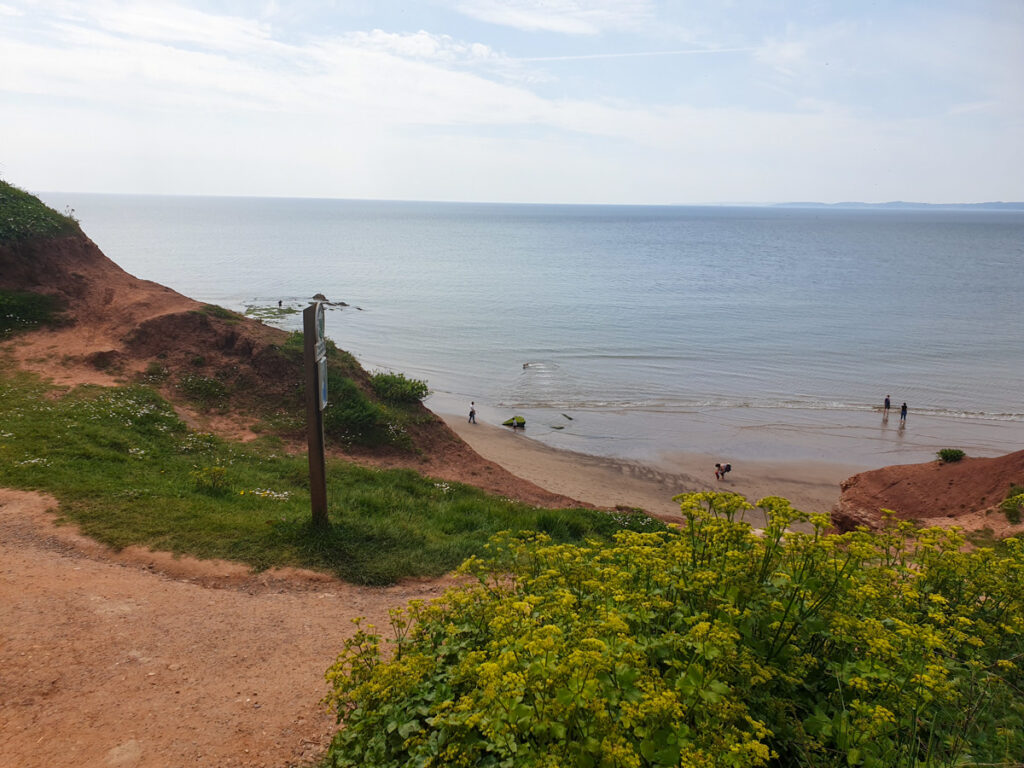
The “Jurassic Coast” is named after the Jurassic period, which is one of the three geological time periods (Triassic, Jurassic, and Cretaceous) represented in the area’s rock formations.
The coastline is particularly renowned for its extensive and well-preserved Jurassic period fossils.
The Jurassic Coast name stuck (I guess it sounds catchier than Mesozoic Coast!) but it’s often used as an umbrella term for these Mesozoic eras.
But the Jurassic Coast is much more than Jurassic – it actually tells a more comprehensive story of geological progression, with rocks from the older Triassic period and younger Cretaceous period also present.
So while the name’s not entirely accurate, it’s quite catchy and memorable (thanks to Jurassic Park if anything!) and it does represent part of the coastline!
Where does the Jurassic Coast start and finish?
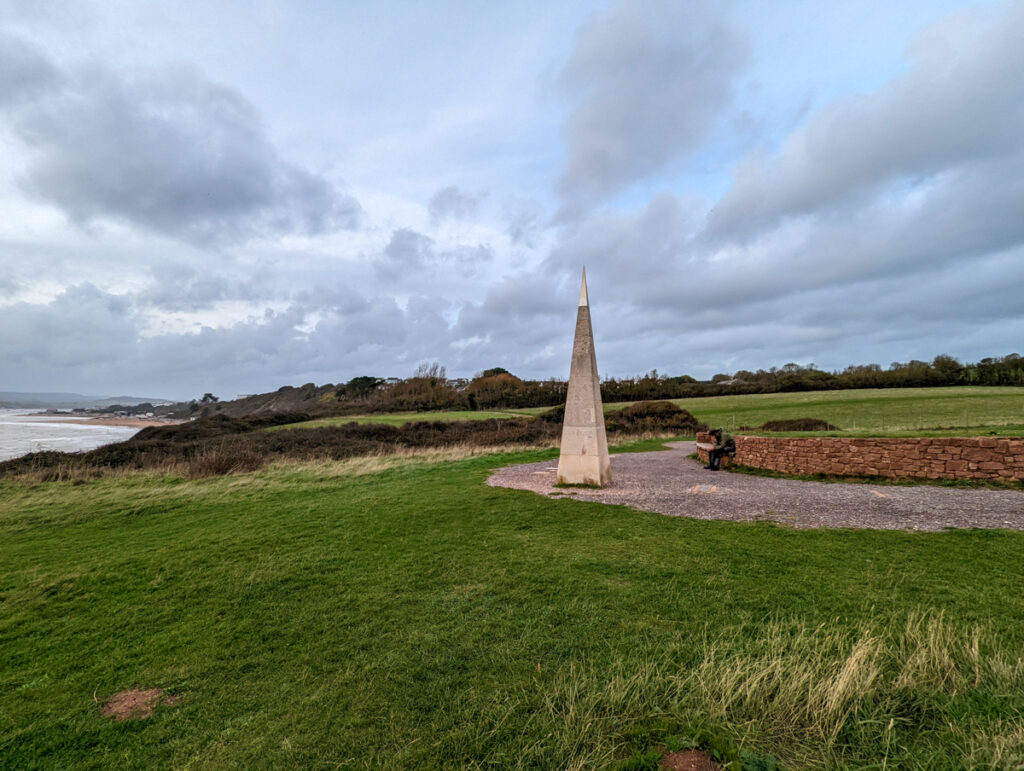
The Jurassic Coast starts at Orcombe Point near Exmouth and ends at Old Harry Rocks which is on Dorset’s Isle of Purbeck, at the end of Studland Bay.
Many people claim that Old Harry Rocks is the beginning of the Jurassic Coast and Orcombe Point is the end – but as an Exmouth local (and tour guide!) I tend to dispute this by arguing that East Devon is the start – as it was here where it all began.
Did dinosaurs live on the Jurassic Coast?
Yes, dinosaurs lived on what is now the Jurassic Coast – although, at the time, the landscape looked a lot different! You can discover the dinos that populated the coastline through its fossils, many of which are in display in the region’s many museums (Charmouth and Lyme Regis have the most fossil-focused museums).
Who found the Jurassic Coast?
Nobody really “found” the Jurassic Coast – it’s been sitting, along the southern border of Devon and Dorset, long before humans populated the world.
Locals would have known that the heritage coast was there. But one of the most famous early fossil collectors was Lyme Regis resident Mary Anning, who was sadly only really celebrated posthumously.
Her work, and that of subsequent geologists, would cause the Jurassic Coast to be compiled and designated a UNESCO World Heritage Site in 2001.
Why is the Jurassic Coast red?
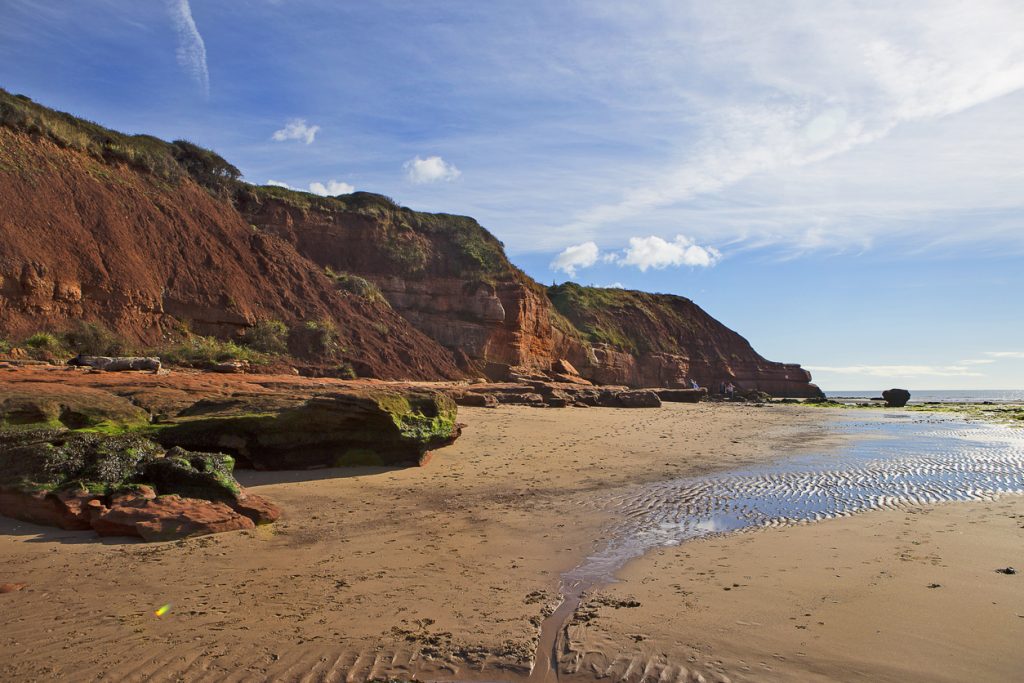
The Devon Jurassic Coast is red due to the fact that the cliffs used to be an inland desert.
They were on the latitude of where the Sahara is these days; and they’ve still retained their rich rust-coloured sandstone that you might expect to see many degrees further south!
What city is near the Jurassic Coast?
As the Jurassic Coast is 95 miles long, it depends on which part you’re looking at.
Exeter is the closest city to any point on the Jurassic Coast – it’s just 12 miles from Orcombe Point.
South West England’s not renowned for its cities, but Bournemouth is a large town that’s close to the other end of the Jurassic Coast, at Old Harry Rocks.
The closest city to Old Harry Rocks is Southampton (although it’s still 40 miles away).
Dorchester is the county town of Dorset and sits inland but close to many attractions on the Dorset Jurassic Coast.
Bristol isn’t close to the Jurassic Coast, but it does have direct trains to Weymouth (taking 2 hours 22 minutes) which is right in the heart of the coastline.
What rock is the Jurassic Coast made of?
The Jurassic Coast is primarily made up of sedimentary rocks, specifically limestone and clay.
These rocks were formed over millions of years during the Mesozoic era, approximately 252-66 million years ago.
The limestone found along the coast is known for its fossil-rich nature, with numerous marine fossils preserved within its layers.
The clay formations, on the other hand, provide a geological record of the ancient landscape and environmental conditions.
The combination of these rocks has created a stunning coastline that attracts millions of visitors each year!
Are you ready to visit the Jurassic Coast?
Whether you’re a geology buff or a beach hopper, there’s something for you on this gorgeous slice of English coastline.
From cliffs to unique beaches to fascinating towns and villages, England’s only natural UNESCO site beckons travellers with its allures.
Don’t forget to check out the rest of my Devon and Dorset posts if you’re planning your trip to the south-west, and feel free to reach out to me on Instagram if you have any questions – as mentioned, I live on the coastline and am always happy to help!
Whew! That was a long post – if it’s helped and you’d like to make a contribution to keep this site running, you can buy me a coffee by clicking here.


